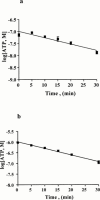Activity of adenosine diphosphates and triphosphates on a P2Y(T) -type receptor in brain capillary endothelial cells
- PMID: 11156575
- PMCID: PMC1572558
- DOI: 10.1038/sj.bjp.0703816
Activity of adenosine diphosphates and triphosphates on a P2Y(T) -type receptor in brain capillary endothelial cells
Abstract
1. A P2Y (nucleotide) receptor activity in a clonal population (B10) of rat brain capillary endothelial cells is coupled to inhibition of adenylyl cyclase and has functional similarities to the P2Y(T) (previously designated 'P2T') receptor for ADP of blood platelets. However, the only P2Y receptor which was detectable in a previous study of B10 cells by mRNA analysis was the P2Y(1) receptor, which elsewhere shows no transduction via cyclic nucleotides. We have sought here to clarify these issues. 2. The inhibition of forskolin-stimulated adenylyl cyclase induced by purified nucleotides was measured on B10 cells. The EC(50) value for 2-methylthioADP (2-MeSADP) was 2.2 nM and, surprisingly, 2-MeSATP was an almost equally strong agonist (EC(50)=3.5 nM). ATP and 2-ClATP were weak partial agonists (EC(50)=26 microM and 10 microM respectively) and under appropriate conditions could antagonise the activity on 2-MeSADP. 3. A known selective antagonist of the platelet P2Y(T) receptor, 2-propylthioadenosine-5'-(beta,gamma)-difluoromethylene) triphosphonate (AR-C 66096), was a competitive antagonist of this B10 cell receptor, with pK(B)=7.6. That ligand is inactive at the P2Y(1) receptor in the same cells. Conversely, the competitive P2Y(1) receptor antagonists, the 3', 5'- and 2', 5'-adenosine bis-monophosphates, are, instead, weak agonists at the adenylyl cyclase-inhibitory receptor. 4. The inhibition of adenylyl cyclase by 2-MeSADP was completely abolished by pertussis toxin. 5. In summary, these brain endothelial cells possess a P2Y(T)-type receptor in addition to the P2Y(1) receptor. The two have similarities in agonist profiles but are clearly distinguishable by antagonists and by their second messenger activations. The possible relationships between the B10 and platelet P2Y(T) receptors are discussed.
Figures







Similar articles
-
Characterization and channel coupling of the P2Y(12) nucleotide receptor of brain capillary endothelial cells.J Biol Chem. 2002 Aug 30;277(35):31390-400. doi: 10.1074/jbc.M110714200. Epub 2002 Jun 21. J Biol Chem. 2002. PMID: 12080041
-
The P2Y purinoceptor in rat brain microvascular endothelial cells couple to inhibition of adenylate cyclase.Br J Pharmacol. 1996 Dec;119(7):1385-92. doi: 10.1111/j.1476-5381.1996.tb16050.x. Br J Pharmacol. 1996. PMID: 8968547 Free PMC article.
-
Benzoyl ATP is an antagonist of rat and human P2Y1 receptors and of platelet aggregation.Biochem Biophys Res Commun. 1999 Mar 5;256(1):94-7. doi: 10.1006/bbrc.1999.9558. Biochem Biophys Res Commun. 1999. PMID: 10066429
-
The P2 receptors and congenital platelet function defects.Semin Thromb Hemost. 2005 Apr;31(2):168-73. doi: 10.1055/s-2005-869522. Semin Thromb Hemost. 2005. PMID: 15852220 Review.
-
Molecular recognition at adenine nucleotide (P2) receptors in platelets.Semin Thromb Hemost. 2005 Apr;31(2):205-16. doi: 10.1055/s-2005-869526. Semin Thromb Hemost. 2005. PMID: 15852224 Free PMC article. Review.
Cited by
-
Inhibition of adenylyl cyclase by neuronal P2Y receptors.Br J Pharmacol. 2002 Feb;135(3):673-84. doi: 10.1038/sj.bjp.0704514. Br J Pharmacol. 2002. PMID: 11834615 Free PMC article.
-
Activation of microglial P2Y12 receptor is required for outward potassium currents in response to neuronal injury.Neuroscience. 2016 Mar 24;318:22-33. doi: 10.1016/j.neuroscience.2016.01.008. Epub 2016 Jan 12. Neuroscience. 2016. PMID: 26791526 Free PMC article.
-
Expression of the P2Y1 nucleotide receptor in chick muscle: its functional role in the regulation of acetylcholinesterase and acetylcholine receptor.J Neurosci. 2001 Dec 1;21(23):9224-34. doi: 10.1523/JNEUROSCI.21-23-09224.2001. J Neurosci. 2001. PMID: 11717356 Free PMC article.
-
Regulating quantal size of neurotransmitter release through a GPCR voltage sensor.Proc Natl Acad Sci U S A. 2020 Oct 27;117(43):26985-26995. doi: 10.1073/pnas.2005274117. Epub 2020 Oct 12. Proc Natl Acad Sci U S A. 2020. PMID: 33046653 Free PMC article.
-
ATP induces synaptic gene expressions in cortical neurons: transduction and transcription control via P2Y1 receptors.Mol Pharmacol. 2010 Dec;78(6):1059-71. doi: 10.1124/mol.110.066506. Epub 2010 Sep 16. Mol Pharmacol. 2010. PMID: 20847060 Free PMC article.
References
-
- BARNARD E.A., SIMON J., WEBB T.E. Nucleotide receptors in the nervous system. An abundant component using diverse transduction mechanisms. Mol. Neurobiol. 1997;15:103–130. - PubMed
-
- BOARDER M.R., HOURANI S.M.O. The regulation of vascular function by P2 receptors: multiple sites and multiple receptors. Trends Pharmacol. Sci. 1998;19:99–107. - PubMed
-
- BOYER J.L., LAZAROWSKI E.R., CHEN X-H., HARDEN T.K. Identification of a P2Y-purinergic receptor that inhibits adenylyl cyclase. J. Pharmacol. Exp. Ther. 1993;267:1140–1146. - PubMed
-
- BOYER J.L., ROMERO-AVILA T., SCHACHTER J.B., HARDEN T.K. Identification of competitive antagonists of the P2Y1 receptor. Mol. Pharmacol. 1996;50:1323–1329. - PubMed
-
- BUELL G., MICHEL A.D., LEWIS C., COLLO G., HUMPHREY P.P.A. P2X1 receptor activation in HL60 cells. Blood. 1996;87:2659–2664. - PubMed
Publication types
MeSH terms
Substances
Grants and funding
LinkOut - more resources
Full Text Sources
Other Literature Sources
Molecular Biology Databases
Research Materials
Miscellaneous

